The rapid growth of network traffic has led to the evolution and upgrading of network infrastructure design. When migrating server room hardware equipment from Giga to 10G, 40G, 100G, or even 400G bandwidth, what do you need to modernize your network cabling?
As data center networks grow, faster two-tier Clos networks have been widely deployed in the modern data center to improve network latency, expand bandwidth, and foster scalability. Devices in the Leaf-Spine architecture include, for example, small form-factor pluggable plus (SFP+) modules for 10G applications. SFP+ is a type of transceiver device that has been standardized by the MSA (Multi-Source Agreement), which defines the mechanical interface, electrical interface, Digital Diagnostics Monitoring (DDM) feature, and so on. Under this agreement, multiple manufacturers can make products that are compatible across vendors.
Besides SFP+, MSA also defines the SFP28 (25G), QSFP+ (40G), and QSFP28 (100G) modules that are commonly used in switches, servers, or storage to transmit huge volumes of data in a data center or server room.
Copper cabling with RJ-45, GG45, or TERA connectors are not compatible with these pluggable interfaces. What cabling options can be used to modernize network cabling?

Figure 1. Modern Data Center Architecture
BICSI, 2019
AOC is commonly used in the racks such as Top-of-Rack (TOR) and End-of-Row (EOR). AOC is a fixed-length cable that consists of optical fiber, fiber optic transceivers, control chip, and modules, used in 10 Gbps to 400 Gbps networking environments. AOC active optical cable uses a length of optical fiber cable to connect an optical transceiver A and optical receiver module B (Figure 2).
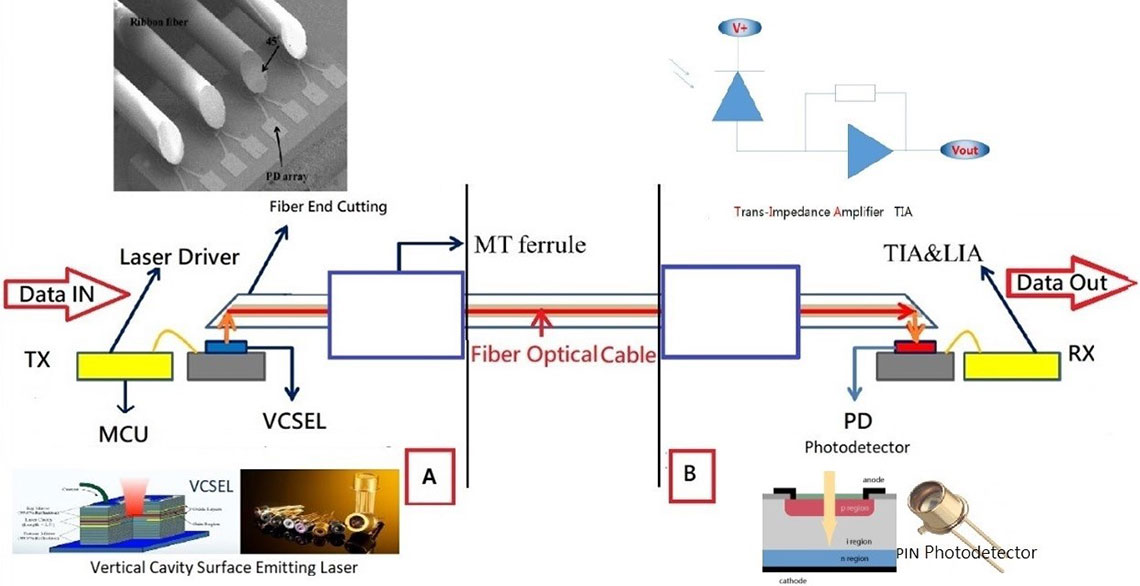
Figure 2. AOC key components and transmission flow
The electrical signal input from TX is converted into an optical signal of a specific wavelength by an electro-optical converter IC and vertical cavity surface emitting laser (VCSEL), then the optical signal is modulated, coupled, and input into the optical cable. After the optical signal reaches the B end through the optical cable, the photodetector and O/E Converter IC detect the optical signal, then the Trans-Impedance Amplifier (TIA) amplifies the signal and outputs the corresponding electrical signal to symmetrically transmit the signals in the AOC.
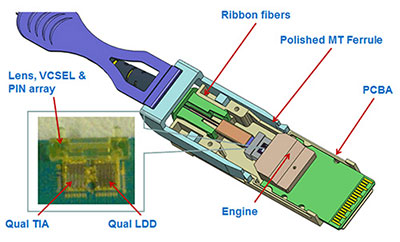
Figure 3. AOC Scheme
NKUST
AOC can be a direct end-to-end cable (Figure 4) or a breakout assembly. The breakout cable is made up of four parallel splitter cables, and the breakout AOC transmits four separate streams, for example, 25 Gbps data over 100 Gbps ribbon cables (4 x 25 = 100 Gbps) in a point-to-multipoint configuration.
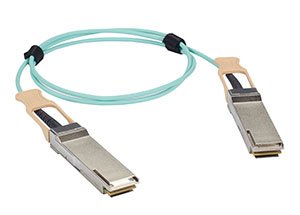
Figure 4. Black Box QSFP 100-Gbps Active Optical Cable (AOC)
Direct Attach Copper cable (DAC) is also a fixed-length cable, comprised of copper wire that connects two fixed transceiver modules on cable ends. DAC is commonly used for data transmission by connecting network switches to switches and stackable switches that support front-panel stacking (FPS), routers, and servers in the rack.
There are two types of DAC cable: passive DAC and active DAC. Passive DAC does not amplify or condition the signals, and the wires solder on the PCBA, which has an EEPROM chip inside. The EEPROM signature enables the host to differentiate between a passive copper cable assembly and a fiber optic module, and the signals are passed through the two-/four-pair copper cable and regenerated by the host networking device. (Figure 5)
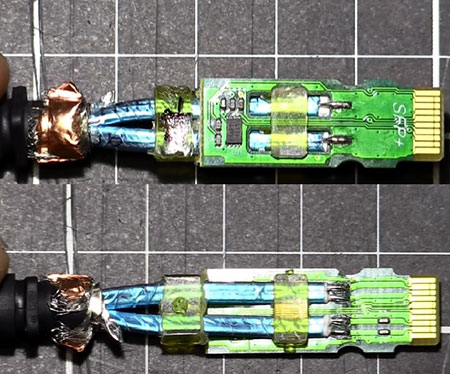
Figure 5. SFP+ passive DAC transceivers teardown
NFM
Passive DAC is used when signal conditioning integrated into a port is provided by a networking device. It costs less than Active DAC, but has a higher upfront cost. Active DAC is used when signal conditioning integrated into a port is not provided by a networking device. Active DAC has similar construction as passive DAC, but it has a chip for signal conditioning, so the Active DAC length limit is longer than passive DAC cable. Generally, Active DAC costs more than Passive DAC.
Fiber Optic Transceivers can be classified by different applications such as package (SFP, QSFP28…) or fiber cable types (SMF/ MMF). A Fiber Optic Transceiver combines a transmitter and receiver function in a single housing by Transmitting Optical Sub-Assembly (TOSA), Receiving Optical Sub-Assembly (ROSA), or the Bi-Directional Optical Sub-Assembly (BOSA), which is the electrical signal and optical signal converting component, and the VSCEL; MCU, etc. cortical parts integrated into a module (Figure 6). The fiber optic cable connects with two fiber optic transceivers for transmitting signals; it offers more flexibility in your server room by changing fiber cable or transceiver model.
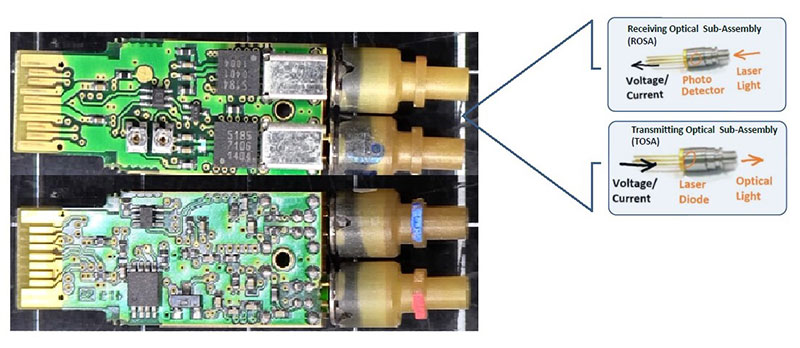
Figure 6. SFP LC MM transceivers teardown
NFM

Figure 7. Black Box SFP, SM, LC transceiver
When selecting AOCs, DACs, and optical transceivers for high-speed interconnects, consider three elements: (1) data throughput, (2) transmission distance, and (3) costs.
DACs have the lowest cost when compared to AOCs and optical transceivers, but passive DACs typically work only within 22.9 feet (7 meters), and active DACs can reach up to a maximum of 32.8 feet (10 meters) for data transmission. Based on the latest technology, DACs can support up to 400 Gbps data rates. DACs feature 24- to 30-AWG copper wire, with a bigger bend radius (Figure 8) when compared to AOC fiber wires, so DACs take up more room than AOCs in tight-space applications.

Figure 8. A minimum bend radius of DAC
When comparing AOC, DAC, and optical transceivers, 100 M is the longest length of AOC, priced in-between optical transceivers and DAC. Using a singlemode AOC cable can extend the transmission length up to 328 feet (100 meters) under 200 Gbps bandwidth (NRZ/PAM4).
Using optical transceivers to connect to the fiber cable preserves the flexibility to change the network architecture in the future, since you can change the combination of transceiver and fiber cable anytime. A transceiver solution costs more than DAC and AOC, because transceiver modules need higher coupling technology, but transceivers deliver the most bandwidth and transmission distance (Figure 9).

Figure 9. DAC, AOC, and transceivers application comparison
NVIDIA
Bit Error Rate (BER) is a critical factor of single correction to ensure cables will be functional when connected to the networking devices. BER measures the performance of data transmission, and the standard equation for a bit error rate measurement is Bit Error Rate = Number of Bit Errors/Total Number of Bits. Eye Diagram Mask Margin, Eye Crossing, and Jitter Analysis are also the critical factors of signal quality.
IEEE defines the BER of 1E-5 for Ethernet that is corrected with forward error correction (FEC) in the host to 1E-12. InfiniBand assumes no use of FEC in the host and requires 1E-15 BER.
Black Box AOC and DAC are compatible with Cisco, and are 100% Quality tested before shipping. Black Box provides the Transceivers, AOC, DAC, and MTP trunk cables you need to modernize your modern network cabling. Leverage our Gbps to 100 Gbps solutions to modernize your server room today!
| Data Rate | Module | Transceiver | Connector | Cable | |||||||||
|---|---|---|---|---|---|---|---|---|---|---|---|---|---|
| MMF | SMF | 1000/10G BASE-T | Duplex LC | MTO-12 (8 Fibers) | RJ45 | CAT6A MAX Length | OM3 MAX Length | OM4 MAX Length | OS1 MAX Length | DAC | AOC | ||
| 1 Gb | SFP | SX (LFP441) | Y | 550M | 500M | ||||||||
| LX (LFP413) | Y | 10KM | |||||||||||
| SerDe (LFP415) | Y | 100M | |||||||||||
| SGMII (LFP416) | Y | 100M | |||||||||||
| SGMII (LFP443) | Y | 100M | |||||||||||
| 10Gb | SFP+ | SR (LSP441) | Y | 300M | 400M | 0.5M; 1.5M; 1M; 2M; 3M; 5M | 1M; 2M; 3M; 5M; 7M; 10M | ||||||
| LR (LSP442) | Y | 10KM | |||||||||||
| LSP443 | Y | 30M | |||||||||||
| 25Gb | SFP28 | SR (Null) | LR (Null) | Duplex LC | 1M; 3M; 5M | ||||||||
| 40Gb | QSFP+ | SR4 (QSFP541) | LR (Null) | Y | 100M | 150M | 0.5M; 1M; 2M; 3M; 5M | 1M; 2M; 3M; 5M; 10M; 15M | |||||
| 100Gb | QSFP28 | SR4 (QSFP441) | Y | 70M | 100M | 3M; 5M; 7M; 10M; 15M; 30M | |||||||
| LR4 (QSFP442) | Y | 10KM | |||||||||||
| Notes: 1. (Black Box P/N) 2. All Black Box SFP Modules feature Extended Diagnostics. | |||||||||||||
Figure 10. Black Box Gbps to 100-Gbps Fiber cabling solutions

Product Engineer
George Liu has 12 years' experience in the cabling, data, and video connectivity industry. As a Project and Product Manager at Black Box, he works directly with domestic and international OEM suppliers on new product launches. George is a certified PMP and CQE, and he is a master's candidate in the industrial management program at National Taiwan University of Science and Technology.